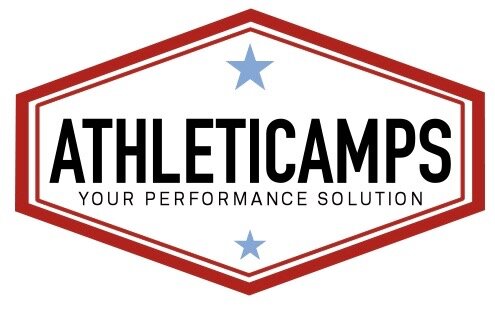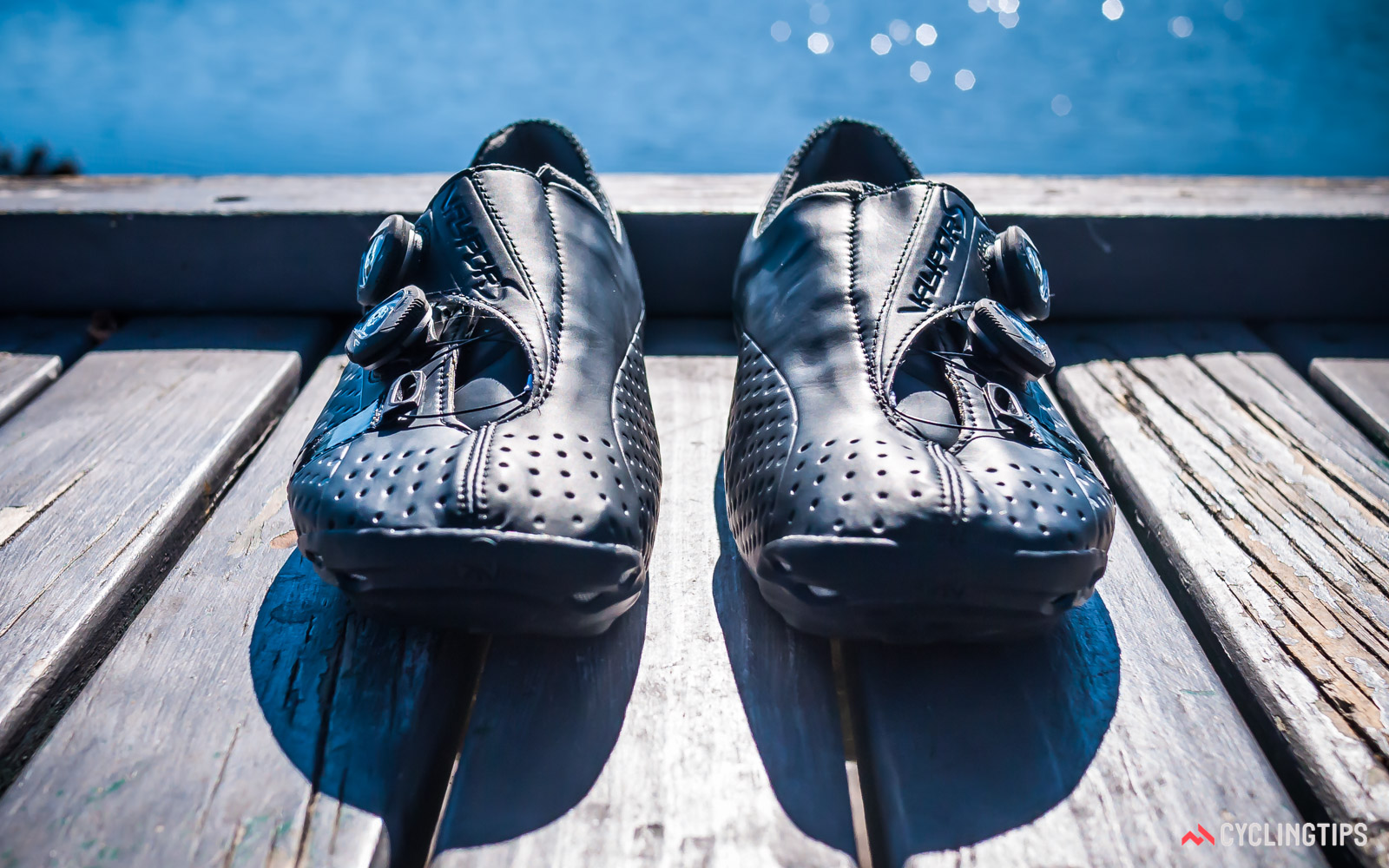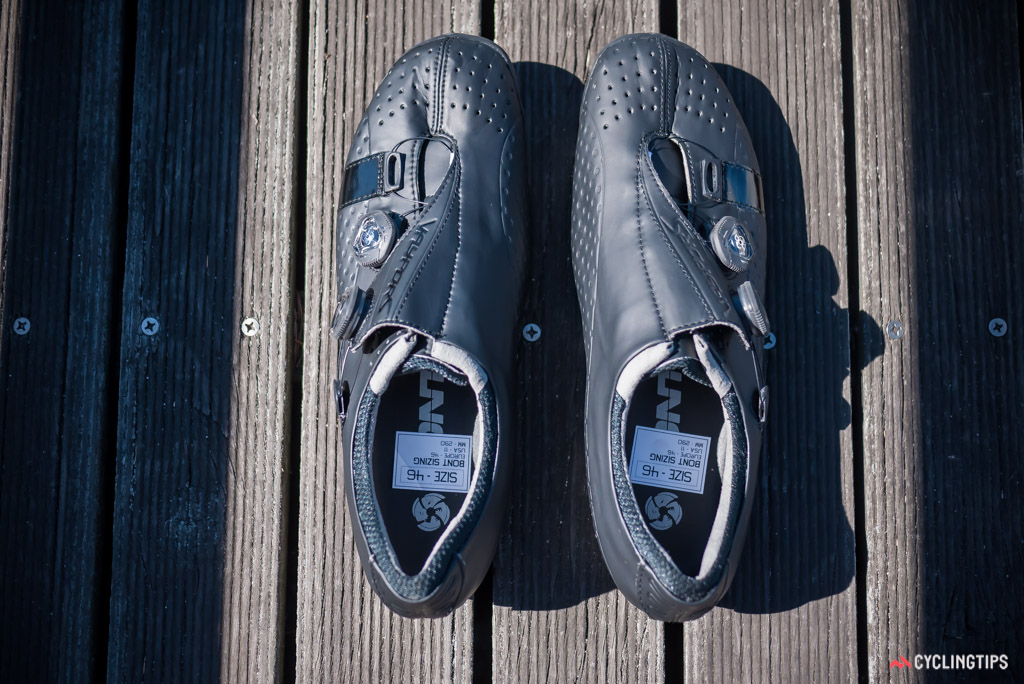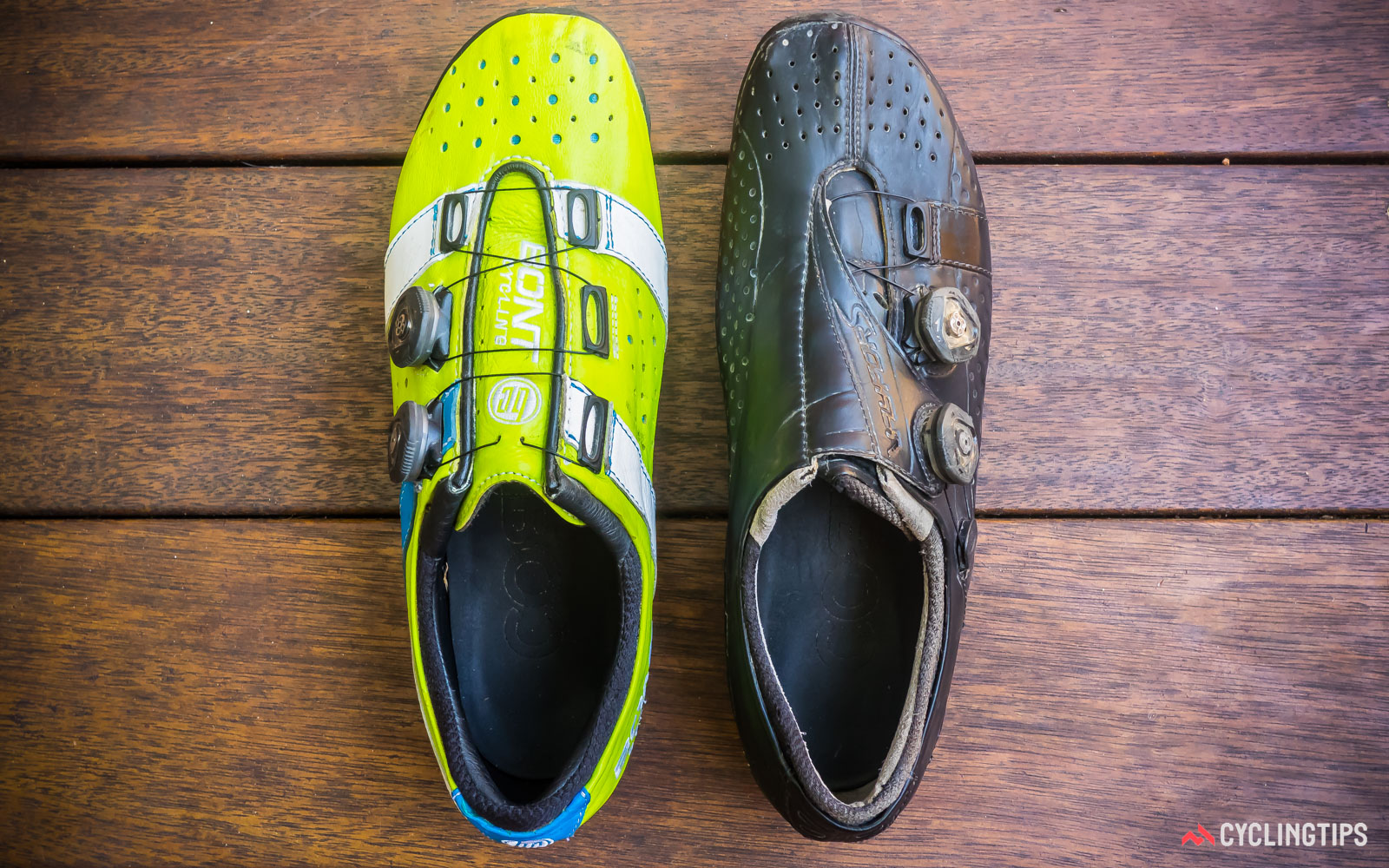The Vaypor S is Bont’s new flagship racing shoe and one that continues with the company’s distinctive fit while incorporating Boa’s new IP1 reels. In this review, CTech editor Matt Wikstrom investigates the philosophy behind Bont’s shoe design as he considers the performance of the Vaypor S.
Bont is an Australian company created in 1975 by Inze and Sara Bont. The business was born out of the couple’s interest in ice speed skating. At the time, ice skates used leather uppers that were too supple for Inze’s liking. He started experimenting with fibreglass for increasing support around the ankle of the boot and found it improved his performance. Soon he had many requests for fibreglass boots from his friends and it was enough to inspire a small business.
Once established, Bont Skates grew to the point where Inze was making up to 200 pairs of boots a week. He pioneered the use of cutting edge materials such as Kevlar, Velcro, neoprene, carbon fibre and heat-moldable thermoplastics during the ‘80s and ‘90s. His designs were quickly translated for roller-skating and inline-skating, and the company became the world’s largest producer of handmade skating boots.
Bont started working on a cycling shoe in 2007, adopting Inze’s one-piece construction method and heat-moldable carbon fibre for the outsole. Olympic athletes played a key role in the product’s development and once released, the A1 was immediately noticed for the stiffness of its sole. There was also the novelty of a heat-moldable shoe.
Bont’s range of cycling shoes has grown considerably since 2007 under the direction of Sydney-based CEO Steven Nemeth. There are now shoes for road, track, off-road, and triathlon in its current catalogue. Bont also has an extensive custom shoe program that allows customisation of the shoe’s appearance as well as its fit.
When Bont released the Vaypor a few years ago, it was designed as a premium race shoe and built to address the needs (and withstand the power output) of professional riders. In contrast, the Vaypor+ that followed in 2013 was designed for sportif riders where there was greater emphasis on all-day comfort.
Now there is the Vaypor S, a successor to the Vaypor, which updates Bont’s design for a high-end racing shoe with new materials and a revised retention strategy. The Vaypor S utilises the same Durolite uppers introduced with the Vaypor+, while Boa’s newest cable reels have been incorporated into a retention system designed for lossless power transfer.
I recently spent a month getting to know the Vaypor S and while it gave me a chance to learn more about the new shoes, it also served as an introduction to Bont’s unique design and fit philosophy.
BONT’S DESIGN PHILOSOPHY
Bont says that they’re underlying philosophy for the design and fit of their shoes is unique, departing radically from conventional thinking around cycling shoe design.
According to Steven Nemeth, Bont’s CEO, “Our philosophy is all about letting the foot do its natural thing.” While the human body may not have been designed for cycling, Bont’s goal is to create a platform that allows the body to function in a natural way.
For this reason, Bont says they utilise “anatomical shaping” for all of its shoes, yielding a much rounder toe box compared to other brands. “Your foot is not pointed,” says Nemeth, “which is essentially what most cycling shoes are. Aesthetically, that does look pretty, but it does absolutely nothing for your feet. The only way it is really going to hold the foot in place is to basically restrict the foot as much as it can.”
BONT’S SIZING STRATEGY
Bont aims to provide ample room for the feet because they will swell with exercise. The extra room also encourages circulation in the feet for greater comfort. At the same time, the toes can spread out so that the load can be distributed over the largest possible surface area.
Accordingly, Bont believes that the ideal shoe length affords 3-4mm of space when fitted at rest. The shoe should also be wide enough so that that the feet can’t touch the sides. To help with this, Bont offers a choice of four widths—stock, narrow, wide and Asian fit—for all of their high-end shoes (there is no narrow option for entry- and mid-level shoes, while Asian fit suits wide feet with low volume and a narrow heel).
I have worn size 44 shoes for the last two decades, yet Bont recommended and supplied size 46 Vapor S shoes for this review to provide that extra 3-4mm of length. Prospective buyers need not guess at their shoe size though, as Bont has developed a sizing wizard for determining the ideal shoe size and width for every customer.
Seasoned riders may worry at the extra length for a shoe, because it is normally enough to allow the heel to move around and even come out of a conventional cycling shoe. However, Bont shapes the heel of their shoes to cup the heel rather than simply wrapping around it like a conventional shoe does. As a consequence, I found it impossible to lift my heel out of the size 46 shoes.
It is this last point that Nemeth says serves as the best test for Bont’s sizing. “Do the shoe up, not tight, just standard. If you grab the heel cup, you shouldn’t be able to pull the shoe off.”
HEAT MOLDING
Bont’s cycling shoes have always been heat moldable thanks to the thermoresin utilised for the carbon outsoles. Specifically developed to soften at a relatively low temperature of 60-70°C, owners are able to use a conventional home oven to customise the fit of the shoes. There is no limit to the number of times the shoes can be heated and molded, and once the shoes cool, the resin holds its shape indefinitely.
While this feature was crucial for perfecting the fit of their earlier shoes, according the Steven Nemeth, “now 95% of people don’t need it.” Instead, he says heat molding is best suited for accommodating bunions and other bone issues.
SPECIFIC AREAS OF SUPPORT
Bont concentrates on providing support for the foot in three specific areas: lateral support for the forefoot; a sound structure for arch support; and a true heel cup. It is through this combination that Bont’s shoes stabilise the feet without having to trap them in the shoe.
Bont’s outsole is designed to provide a large measure of the shoe’s support, not because it is exceptionally stiff, but because it surrounds the foot. Rather than serving as a platform, Bont’s outsole is like a tub or boat, and the foot sits within it rather than on top of it.
At the front of the shoe, the sides of the tub provide lateral support by preventing the feet from spilling over the edge of the outsole. Bont also builds torsional flex into the outsole and the uppers of the shoes that minimises undue stress on the hips and knees, especially when the rider is rocking on the pedals while sprinting or climbing out of the saddle. “If we can stop your foot rotating,” says Nemeth, “then we can basically stabilise your ankle and stabilise your knees for better knee and hip tracking.”
Bont stiffens the midfoot of its shoes to provide longitudinal support, but the amount of direct arch support is purposefully neutral. “I’m a big believer that people should actually get proper inner soles,” says Nemeth, “and by that I mean they need to have a look at if they have a high arch or low arch and buy an inner sole to suit.”
Bont’s structural support in the midfoot area counts as an anchor for the inner sole. “When you put the inner sole in there, it actually allows the inner sole to push against that structural support. We give inner soles a platform to work against.”
Finally, the rear of the shoe is shaped to cup the heel, as mentioned above. This is where the carbon tub is at its deepest, extending to half the height of the shoe, and the upper actually hooks over the heel. Bont contends that the heel cup assists the foot in pulling through the bottom of the pedal stroke as well as during the upstroke.
BENEFITS FOR THE LOWER LEG
Bont’s shoe design promises more than just extra comfort for the feet and a stiff outsole. Once the shoe adequately supports the foot, the lower leg muscles can relax. “One of the most common things that people do in a cycling shoe,” says Steven Nemeth, “is grip with their toes to stop from pulling their heels out. When you start gripping with your toes, the calf muscles really tighten up.”
The benefits for the lower leg aren’t accidental. Bont’s design recognises that the shoes are not only crucial for supporting the feet, but also for supporting much of the rider’s weight. “When we talk about that structural support,” explains Nemeth, “it’s not just about bone structures, it’s also about limiting how many supporting muscles you need to bring into play to help you do the job you need to do.”
“The technology that we use,” says Nemeth, “everything from our anatomical shaping, lateral foot support and the structural arch support, all of the stuff we put in is across our whole range of shoes.”
BEFORE THE RIDE
Taking a closer look at the Vaypor, the shoe utilises the monocoque construction method that was introduced with the Vaypor. One layer of the shoe’s upper is actually included in the carbon outsole as it is constructed, so that the entire shoe is formed as a one-piece structure. This layer of material resembles Kevlar and provides the shoe with enormous resistance to stretch while affording a measure of support.
The outsole is constructed from unidirectional carbon and is heat-moldable thanks to Bont’s proprietary thermoresin (see above). The upper is completed with an outer layer of Durolite while the inside of the shoe is lined with a suede-like material. The padding in the heel and collar is made from memory foam, as is the midsole of the shoe.
At the front of the shoe, there are holes in the toe protector and vents over the toes. Air gills are positioned in the outsole, under the arch, and there is a series of vents in the tongue of the shoe, all to provide the shoe with ventilation and a cooling airflow.
A pair of Boa’s new IP1 reels is used for closing and securing the shoe. The new design ratchets a reel back and forth for fine adjustments, or the reel can be released after pulling upwards on the dial. The two dials form part of a retention system that was designed to withstand the demands of pro sprinters, by pulling the foot towards the rear of the shoe to eliminate heel movement.
Bont’s shoes have always offered a low stack height for the pedal cleat and so it goes for the Vaypor S, which has a stack height of 3.6mm. A standard three-hole configuration is provided for cleat mounting along with a detailed grid to help with positioning the cleat. At the rear of outsole, there is a replaceable heel guard to protect the shoe when walking.
Bont specifies a weight of 230g for the Vaypor S. The shoes sent for review (size 46) averaged 243g each (242g for the left shoe, 244g for the right).
All of Bont’s shoes are handmade in China. The Vaypor S is currently offered in a choice of six colours with a recommended retail of AUD$479/US$459/£325. For more information, visit Bont.
AFTER THE RIDE
From the outset, I had a hard time getting accustomed to the Vaypor S, but by the end of the review period, Bont had managed to overhaul my expectations for cycling shoes. In short, I found all of Bont’s claims held true for these shoes, as I enjoyed a truly comfortable cycling shoe that also felt like it improved my pedal stroke.
At face value, the Vaypor S is a pleasing offering from Bont, but compared to the rest of the market, the shoes look like slippers. The broad round toe box is largely to blame, as is the lazy outsole. It’s a common complaint about Bont’s shoes, but the company steadfastly refuses to satisfy the vanity of road cyclists. Function dictates form, in this case.
As I’ve already mentioned above, Bont is generous with its sizing, preferring that the feet sit well within the shoes. After more than two decades of close-fitting cycling shoes, I was expecting the worst. With a left foot that is 5mm shorter than the right, there was plenty of room for the shoe to fail, yet both heels held firm.
While the sizing seemed adequate for my feet, I struggled with finding a place for my cleats. The outsole was longer and wider than my regular shoes, so where to start? For the first week of riding, I shuffled my cleats around but was never satisfied.
My problem with the cleats mirrored my initial overall dissatisfaction with the shoes. They were never uncomfortable, but I was having trouble getting settled in them. In retrospect, it was as if my feet were disoriented, overwhelmed by all the extra space after so many years of working in close quarters. I found myself longing for the close fit of my regular shoes.
Things started to change during my second week. My appreciation for the Vaypor S started with the heel cup as I tested my confidence in the hold of the shoes. Grinding my way up a short climb, I purposefully dragged my foot through the bottom of the pedal stroke with as much force as my hamstrings could manage, and I discovered that it was translated directly into my pedal stroke. Lifting my heels for the upstroke had the same effect too, and I was able to harness extra energy for my pedal stroke.
There was also a dawning realisation that I was able to spin the cranks faster without my lower legs burning out. Indeed, there was an overall sense that my lower legs had relaxed and I was able to use them with greater intent.
By the close of my second week in the Vaypor S, I had ceased fiddling with my cleats and that sense of disorientation had disappeared. I was no longer distracted by the extra space in the shoes and I was discovering how sure and efficient my feet were on the pedals.
At this point, I switched back to my regular shoes, and I was surprised at my discomfort. I was hyper-aware at how much the shoes were forcing my toes together. The tension had returned to my lower legs and I couldn’t push on the pedals as effectively as I had with the Bonts. Barely 15 minutes into my ride, I had to turn around to get rid of the shoes. (Interestingly, by the time I arrived home, my legs had started to relax in my regular shoes and I re-discovered some of my familiar pedalling sensations. My toes still felt distorted, but my awareness of it was starting to fade.)
Returning to the Vaypor S provided a contrast for the better as my toes relished the extra accommodation. What had been so distracting was now familiar and encouraging, and I was sold on the value of the shoes.
Bont is well known for the stiffness of its outsoles, but what some may describe as stiffness I see as more a matter of support. I’ve already mentioned how effective the heel cup was; midfoot support was equally sure and firm (and most obvious next to my arches) while the extra surface area at the forefoot was clearly perceptible. Where once I felt as if I was dancing on my toes, the Vaypor S afforded me the use of my whole foot, and as a consequence, my pedal stroke felt more effective.
Finally, it’s worth noting that I had no trouble using my custom orthotics with the Vaypor S. Boa’s IP1 reels continue to impress by offering perfect increments for adjusting the tension of the uppers while allowing easy removal of the shoes. And the grid on the outsole is the perfect device for positioning and adjusting the cleats.
SIDE-BAR: HOW DOES BONT’S VAYPOR+ COMPARE WITH THE VAYPOR S?
Bont’s Vaypor+ follows the same design philosophy of the Vaypor S and shares many of the same features, however the the uppers are designed to provide a more forgiving hold on the foot. As such, Bont classifies the Vaypor+ as a sportive rather than a racing shoe.
One of the major differences relates to the uppers: the Vaypor+ makes use of kangaroo leather rather than Durolite and is lined with cow hide instead of faux suede. Kangaroo leather is well known for its resilience and stretch-resistance, so it is a prudent yet expensive choice for a shoe. It also adds a little to the weight of the shoe (a size 46 sample weighed 281g compared to 243g for Vaypor S) but buyers are more likely to notice the difference in cost (AUD$599/US$499/£350 versus AUD$479/US$459/£325 for the Vaypor S).
The Vaypor+ features the same Boa IP1 reels and kevlar wires as the Vaypor S, however the upper reel is located in a different position, pulling the shoe together along the midline of the foot rather than reaching around to the side. At face value, this provides a distinct aesthetic for the Vaypor+, but it also moderates the quality of the hold on the foot.
The shaping of the heel cup adds further to this distinction, which is round and more open for the Vaypor+ than the Vaypor S. When viewed side-by-side, it becomes obvious how much extra room the Vaypor+ provides for the mid- and hind-foot regions.
Those differences can be felt when wearing the Vaypor+. Compared to the Vaypor S, I found that the Vaypor+ didn’t provide the same unshakeable hold on my heel. I don’t think my pedal stroke suffered, even when I was pulling hard on the upstroke while out of the saddle, but I preferred the extra security that the Vaypor S had to offer.
The forefoot region of the the Vaypor+ (left) is almost identical to the Vaypor S (right), but one look at the collar of the shoes is all that is needed to appreciate the difference in the mid- and hind-foot regions, which are both more generous for the Vaypor+.
This difference in hold started to pay dividends on long rides, though. If the Vaypor S can be likened to a collared shirt, then the Vaypor + was like a t-shirt, and my feet always felt a little more relaxed after wearing them for five hours or more.
At the front of the shoe, the Vaypor+ provided the same roomy accommodation for my forefoot as the Vaypor S, and my toes enjoyed the same amount of freedom. This is where Bont’s shoes really shine and account for much of the comfort they have to offer.
For those tossing up between the two models, some weight can be given to the difference in the materials used for the uppers, however it’s the amount of hold on the mid- and hind-foot that really differentiates the Vaypor S from the Vaypor+.
FINAL THOUGHTS AND SUMMARY
When I started road cycling at the end of the ‘80s, I used toe clips and straps. While the archaic devices helped harness more energy for my pedal stroke, the straps became increasingly uncomfortable after a couple hours of riding. I was a teenager with limited resources, but I quickly set my mind to getting a pair of clipless pedals. I can still recall my first ride on those pedals, such was the sense of relief and freedom for my feet.
I now feel the same way about Bont’s Vaypor S, though, as I’ve described above, the benefits of the shoes were only slowly revealed to me. My expectations were slow to change, but after a month of wearing the Vaypor S, I don’t see how they will ever be overturned.
Any shoe review is subject to one major caveat, namely the suitability of the fit for the individual. As such, I can’t predict how well the Vaypor S (or any other of Bont’s shoes) will work for another person. Bont’s shoes are, however, well equipped to attend to the needs of the individual with a choice of four widths and a heat-moldable outsole. That’s no guarantee that the shoes will shine like they have for me, but if they have any appeal, then I’d encourage you to give them a try.









